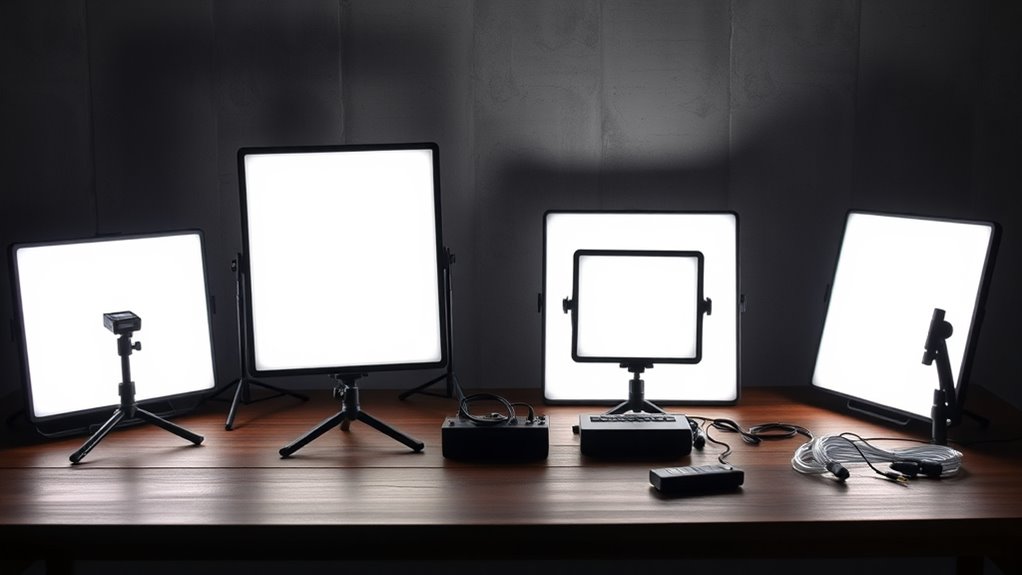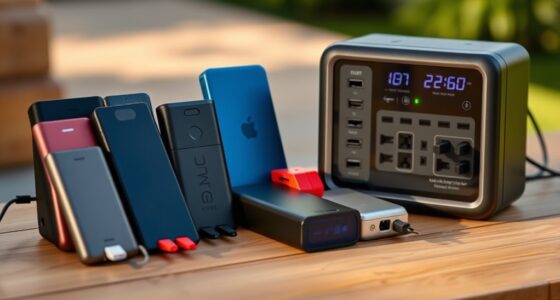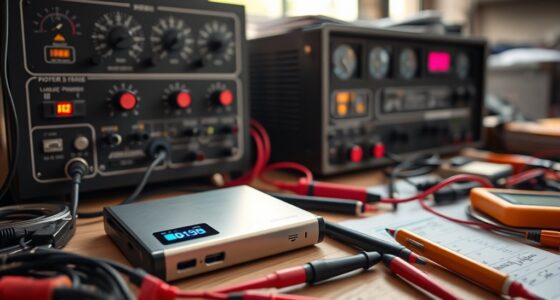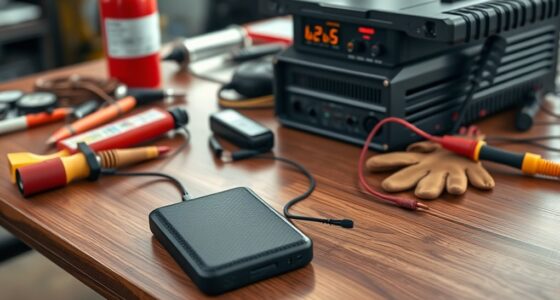Lighting kits for blackouts are portable, easy-to-use systems that turn on automatically when power fails, helping you see safely. They come with rechargeable or disposable batteries and can be fixed or portable, depending on your needs. These kits are designed for quick setup and reliable operation, making emergencies less stressful. If you want to understand how to choose and use them safely, there’s plenty more to cover to keep your space prepared.
Key Takeaways
- Lighting kits for blackouts provide portable, reliable light using rechargeable batteries to ensure safety during power outages.
- They come in various types, including portable, plug-in, or ceiling-mounted, suited for different needs and locations.
- Automatic activation during power failure and regular maintenance keep these lights ready and functioning properly.
- Key features include long battery life, durability, adjustable brightness, and ease of installation.
- Proper handling, storage, and safety practices reduce fire hazards and ensure reliable emergency lighting.
What Are Lighting Kits for Blackouts?
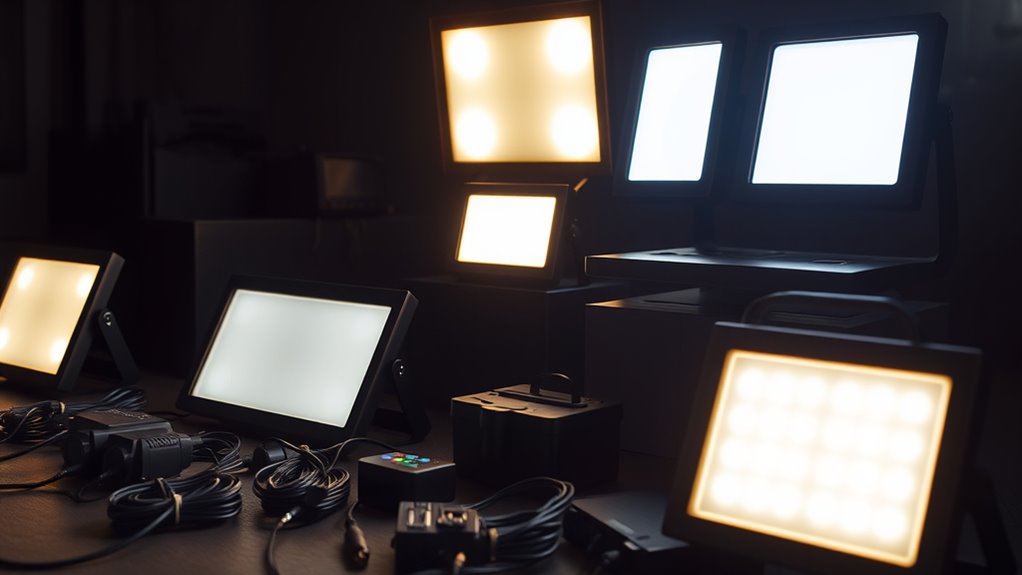
Have you ever experienced a sudden blackout and wondered how to keep your space lit? That’s where lighting kits for blackouts come in. These kits are specially designed to provide portable, reliable light during power outages. They typically include rechargeable batteries with impressive battery life, so you won’t be left in the dark for long. You can install these lighting sources in various locations around your home or office—such as hallways, bedrooms, or emergency exits—to ensure safety and visibility. The installation process is usually straightforward, often involving mounting brackets or simple plug-and-play setups. Lighting kits are a smart addition to your emergency preparedness plan, giving you peace of mind knowing you’ll have dependable lighting whenever the power goes out.
Types of Lighting Kits Available
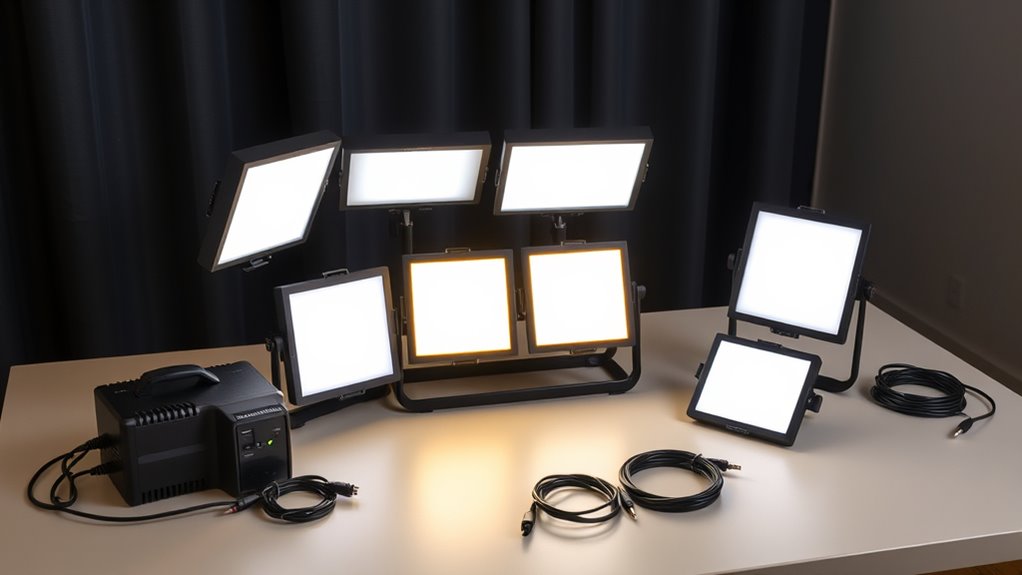
There are several types of lighting kits available to suit different needs during blackouts. Your choice depends on factors like battery options and installation methods. Some kits feature rechargeable batteries, offering long-term use, while others use disposable batteries for quick setup. For installation, you can select between portable, plug-in, or ceiling-mounted kits, depending on your space and convenience. Here’s a quick overview:
| Battery Options | Installation Methods |
|---|---|
| Rechargeable batteries | Portable or wall-mounted |
| Disposable batteries | Plug-in or fixed ceiling |
Whether you prefer easy portability or permanent fixtures, understanding these options helps you pick the right lighting kit for blackout situations. Understanding different types of lighting kits can help you make an informed decision based on your specific needs.
How Do Emergency Lighting Kits Work?
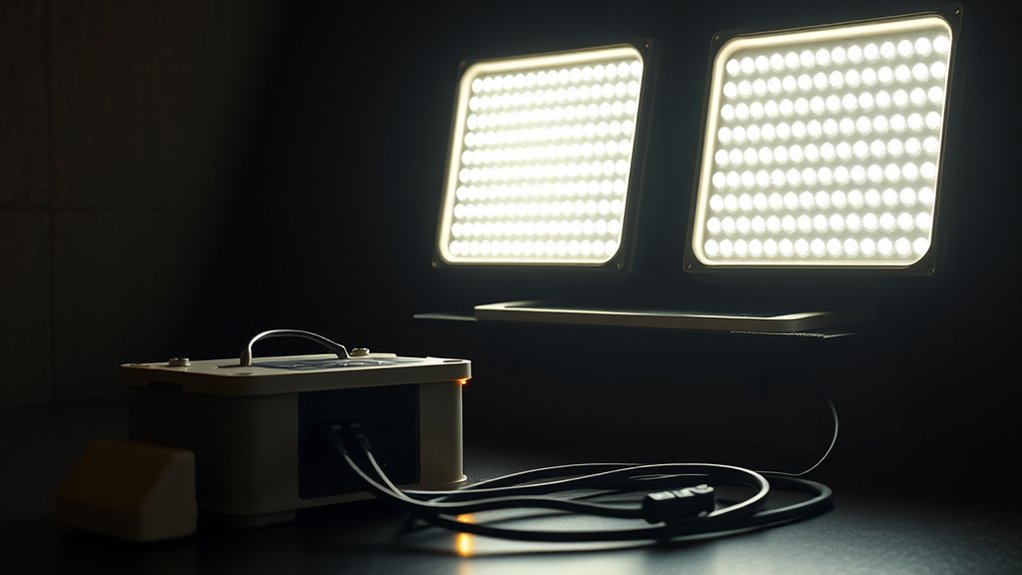
Emergency lighting kits activate automatically when the main power supply fails, ensuring you can see and move safely. They use built-in batteries that power the lights during an outage, providing essential illumination. The battery life is designed to last long enough to guide you to safety, usually between 90 minutes to several hours. When the power goes out, sensors detect the failure and trigger the lights to turn on instantly. The installation process is straightforward; it involves mounting the kit in a strategic location and connecting it to your electrical system. Once installed, the kit continuously charges its batteries while the main power is active, so it’s ready to activate at any moment. This seamless operation keeps you safe during blackouts without constant intervention. Additionally, high-quality emergency lighting kits often incorporate long-lasting batteries that ensure reliable operation during extended outages.
Key Features to Look for in a Lighting Kit

When selecting a lighting kit for blackouts, focusing on key features can guarantee you get reliable and efficient performance. First, check the battery life—long-lasting batteries ensure your lights stay on when you need them most. Look for kits with rechargeable batteries to save money and reduce waste. Portability is equally important; choose lightweight, compact designs that are easy to carry and set up anywhere. A portable kit allows you to move your lighting effortlessly during emergencies or outdoor use. Consider durability too—materials that withstand rough handling will serve you better in blackout situations. Finally, ensure the kit includes adjustable brightness settings so you can customize the light output to suit your needs. These features help you stay prepared, safe, and well-lit during blackouts. Grocery savings strategies can also be applied to purchasing blackout supplies, ensuring you get the best deal possible.
Setting Up Your Blackout Lighting Kit
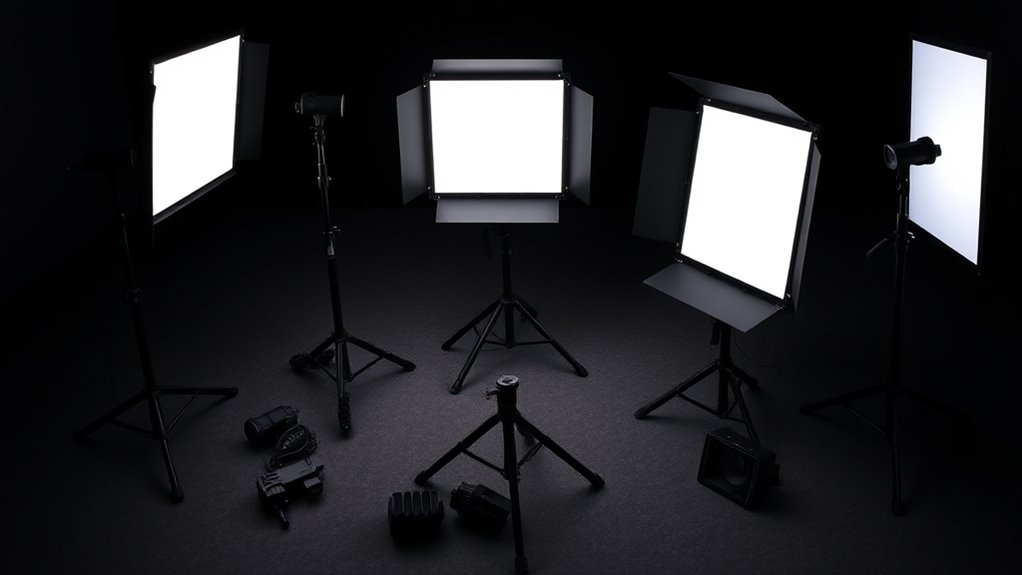
Setting up your blackout lighting kit is straightforward if you follow a few simple steps. First, identify the best spots for your outdoor illumination, such as pathways or seating areas, to enhance safety and ambiance. Connect your decorative lighting components, making sure they’re secure and weatherproof if used outside. Use extension cords or portable power sources if needed, ensuring they’re rated for outdoor use. Arrange the lights to distribute illumination evenly, avoiding dark spots. Test your setup before a blackout to confirm everything works properly. Keep extra batteries or backup power options handy. Properly configuring your kit ensures reliable lighting during power failures while creating a cozy, inviting atmosphere with decorative lighting. Additionally, understanding the divine timing of energy flow can help you optimize your setup for when you need it most.
Benefits of Using Lighting Kits During Power Failures
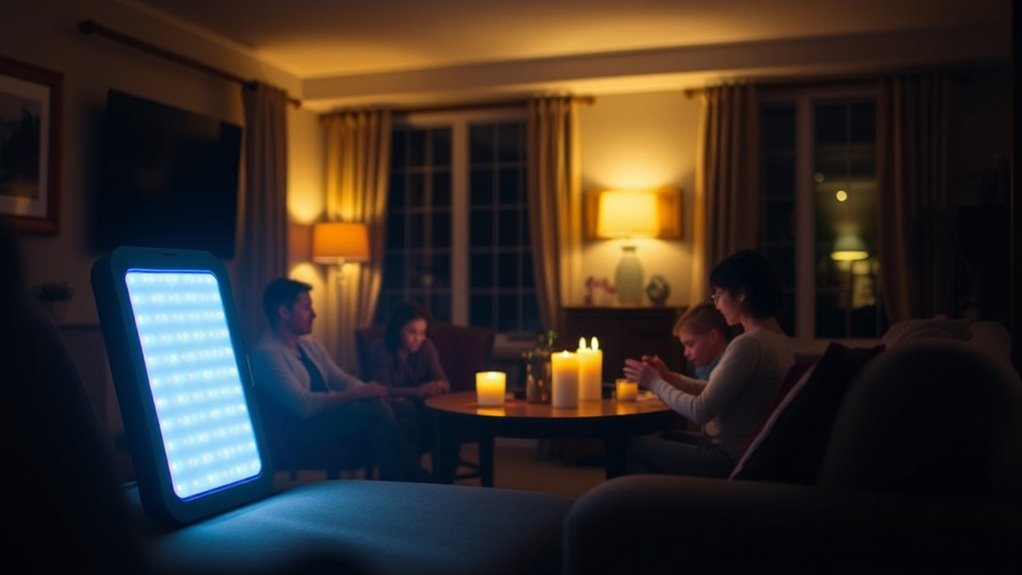
Lighting kits provide a reliable source of illumination during power failures, helping you maintain safety and visibility when it’s most needed. Many kits use solar power, allowing you to recharge them during the day for continuous use at night. This eco-friendly option reduces dependence on the grid and guarantees you have light whenever you need it. Additionally, good battery life means your lighting stays on longer, giving you peace of mind during extended blackouts. With features like rechargeable batteries and solar panels, these kits are cost-effective and sustainable. They help you navigate your home safely, prevent accidents, and keep communication devices powered. Overall, lighting kits enhance your preparedness and ensure you stay safe, visible, and connected when the power goes out.
Tips for Maintaining and Storing Your Lighting Kit
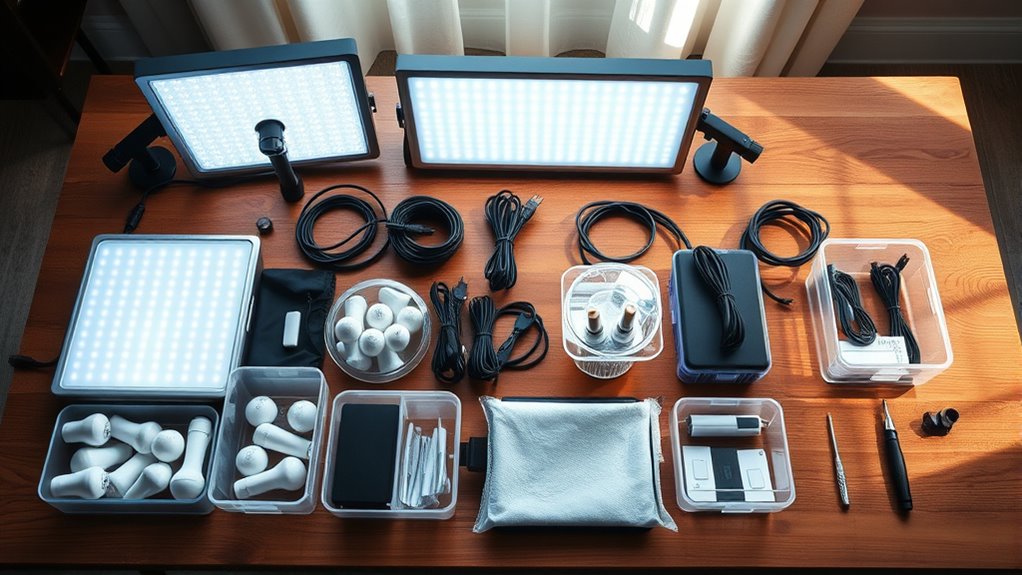
To guarantee your lighting kit works when you need it most, you should follow proper storage techniques and perform regular maintenance checks. Handling the equipment safely prevents damage and keeps it ready for use during blackouts. Staying attentive to these practices helps prolong the life of your lighting kit and guarantees reliable performance. Regularly inspecting your kit for any signs of essential oil contamination can help prevent malfunction or damage.
Proper Storage Techniques
Proper storage is essential to keep your lighting kit in ideal condition and ready for use during blackouts. To maximize battery life and ensure your lights work when needed, store batteries in a cool, dry place away from direct sunlight. Use sturdy storage containers to protect your equipment from dust, moisture, and damage. Keep accessories organized to avoid losing small parts. Label storage bins for quick access during emergencies. Regularly check that batteries are fully charged before storing them, and avoid over-tightening connections. Consider using padded cases for fragile components to prevent breakage. Proper storage techniques help extend your lighting kit’s lifespan, ensuring it’s reliable whenever you need it most. Properly stored gear is always ready to light up your blackout experience. Additionally, understanding retirement planning can help you prepare financially for unexpected events like blackouts, ensuring peace of mind.
Regular Maintenance Checks
Regular maintenance checks keep your lighting kit ready when you need it most. Regularly inspect batteries to ensure they hold a good charge and replace them if the battery life is diminished. Clean all components to prevent dust and dirt buildup, which can affect performance. Check that connectors and cords are intact and undamaged. Review your warranty coverage to understand what repairs or replacements are included if something fails. Test your lighting devices periodically by turning them on and verifying brightness levels. Proper storage between uses also helps maintain functionality. Keeping a maintenance schedule guarantees your kit stays reliable during emergencies, saving you time and frustration when blackout conditions hit. Staying proactive with these checks ensures you’re always prepared with a fully functional lighting kit. Additionally, understanding the best cities to open a restaurant can influence your decision-making if you plan to expand your business or consider future investment opportunities.
Safe Handling Practices
Handling your lighting kit safely is vital to prevent damage and guarantee it’s ready when you need it most. Proper storage and handling reduce fire hazards and ensure electrical safety. Always keep your kit in a dry, cool place away from flammable materials. When handling electrical components, unplug devices before maintenance. Inspect cords regularly for damage or fraying to prevent fire hazards. Use the correct voltage and avoid overloading outlets. Store batteries properly, away from heat sources, to prevent leaks or fires. Keep small parts out of reach of children and pets. Label your kit clearly for easy access during emergencies. Following these safe handling practices helps maintain your lighting kit’s longevity and keeps you safe during blackouts. Additionally, staying informed about AI discoveries in safety and technology can help you adopt innovative safety measures for your equipment.
Comparing Price and Effectiveness of Different Kits

When choosing a blackout lighting kit, it is essential to weigh both the cost and how well each option performs. Battery technology varies notably across kits, affecting both price and effectiveness. Lithium-ion batteries tend to be more expensive upfront but offer longer-lasting power and quicker recharge times, making them more efficient in emergencies. On the other hand, older lead-acid batteries are cheaper but bulkier and less reliable over time. Conducting pricing comparisons helps you find a kit that fits your budget while meeting your needs. Consider not just the initial cost but also the durability and lifespan of the batteries. Evaluating Battery technology helps you select a kit that provides the best balance between affordability and reliable illumination during blackouts.
Safety Precautions When Using Emergency Lighting Solutions
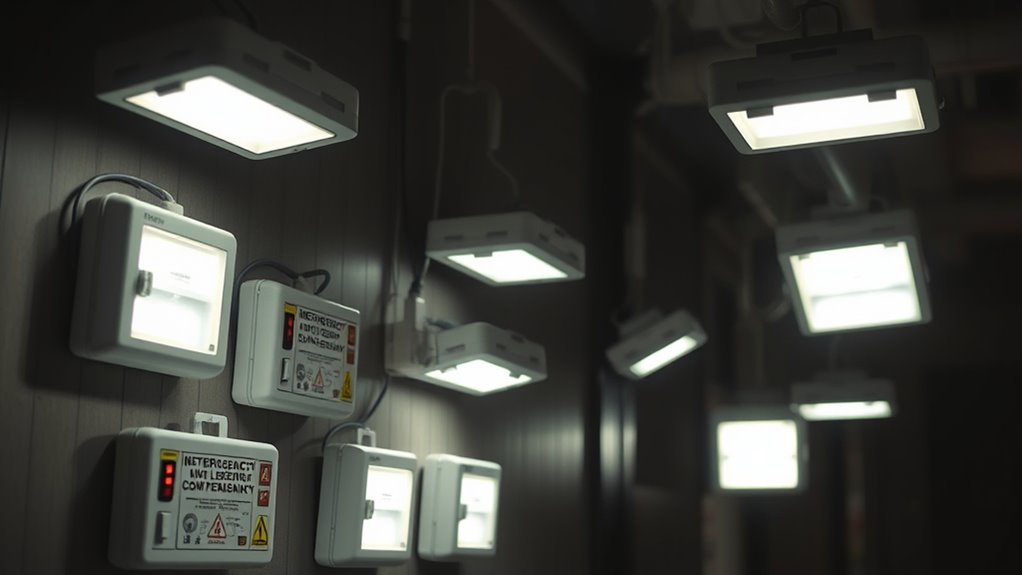
To guarantee your safety during blackouts, it’s essential to follow proper precautions when using emergency lighting solutions. First, always inspect lights for damaged cords or exposed wiring to minimize fire hazards and ensure electrical safety. Keep emergency lights away from flammable materials to prevent fire risks. Use only the recommended batteries and chargers, avoiding makeshift solutions. Never overload power outlets or extension cords, which can cause short circuits. Finally, read the manufacturer’s instructions carefully to avoid misuse. Regularly test your emergency lighting system to confirm functionality. Additionally, monitoring air quality during use can help detect any potential hazards related to improper electrical setups. By following these safety tips, you reduce fire hazards and ensure electrical safety, keeping you and your loved ones safe during blackouts.
Frequently Asked Questions
Can Lighting Kits Be Used Outdoors During Blackouts?
Yes, you can use lighting kits outdoors during blackouts if they feature portable power options and weather resistance. Look for kits specifically designed for outdoor use, with sturdy, weatherproof casings and reliable power sources like batteries or portable generators. This guarantees your lights stay functional and safe despite rain or wind. Always check the manufacturer’s specifications to confirm that the lighting kit is suitable for outdoor blackouts.
How Long Do Blackout Lighting Kits Typically Last on a Single Charge?
Did you know that most blackout lighting kits last between 4 to 12 hours on a single charge? You can expect your kit’s battery lifespan to influence how long it provides light, often around 8 hours on average. Recharge time varies, but many kits take about 4-6 hours to fully recharge. So, plan accordingly—your kit’s runtime depends on its battery capacity and how quickly it recharges.
Are Blackout Lighting Kits Suitable for People With Visual Impairments?
Blackout lighting kits can be suitable for people with visual impairments, especially if they include accessibility features like bright, contrasting lights or tactile controls. You should look for kits designed with these features to guarantee safety and ease of use. While not all kits are perfect, choosing one with high visibility and simple controls helps improve independence and comfort for those with visual impairments.
Do Lighting Kits Require Professional Installation?
Think of installing a lighting kit like assembling a puzzle—sometimes simple, sometimes tricky. You can usually do it yourself by following installation tips, but safety precautions are essential. If you’re unsure or uncomfortable, hiring a professional ensures proper setup and avoids hazards. For example, a friend installed her blackout kit herself, but she accidentally cut a wire—safety precautions could have prevented that. Always assess your skills before starting.
Can Lighting Kits Be Integrated With Home Automation Systems?
Yes, you can integrate lighting kits with your smart home system for seamless control. Many kits are compatible with popular home automation platforms, allowing you to manage them via smartphone apps or voice control. This means you can turn lights on or off, dim them, or set schedules effortlessly. Just make certain your lighting kit supports the automation system you have, and follow the setup instructions to connect everything smoothly.
Conclusion
In a blackout, your lighting kit isn’t just a convenience — it’s your lifeline, illuminating your world when darkness threatens to drown everything. With the right kit, you’ll outshine even the blackest night, turning chaos into clarity. Don’t underestimate the power of a good emergency light; it’s your secret weapon, your beacon of hope, and your ultimate safeguard against total darkness. Be prepared, and let your light never go out!
